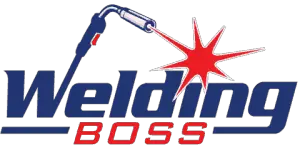This post contains affiliate links to products, services, or education. We may receive a commission for purchases made through links.
With the high heat, UVR (exceptionally bright light that causes sunburn and more on exposed skin) and dangers created by the open flame while welding, it is not safe to operate a welding machine without protective equipment. This is particularly important as it relates to face and eye protection to shield yourself from the harmful light, sparks, and heat that are emitted when the welder is in operation. So how do you buy a welding helmet?
Purchasing a welding helmet will depend on the type of projects you work on and your desired level of convenience. You can find a variety of helmets that range in the color spectrum, viewing size, shade levels, and auto-darkening features. The features you need will vary depending on the helmet type you prefer, which include:
- Passive welding helmets
- Auto-darkening welding helmets
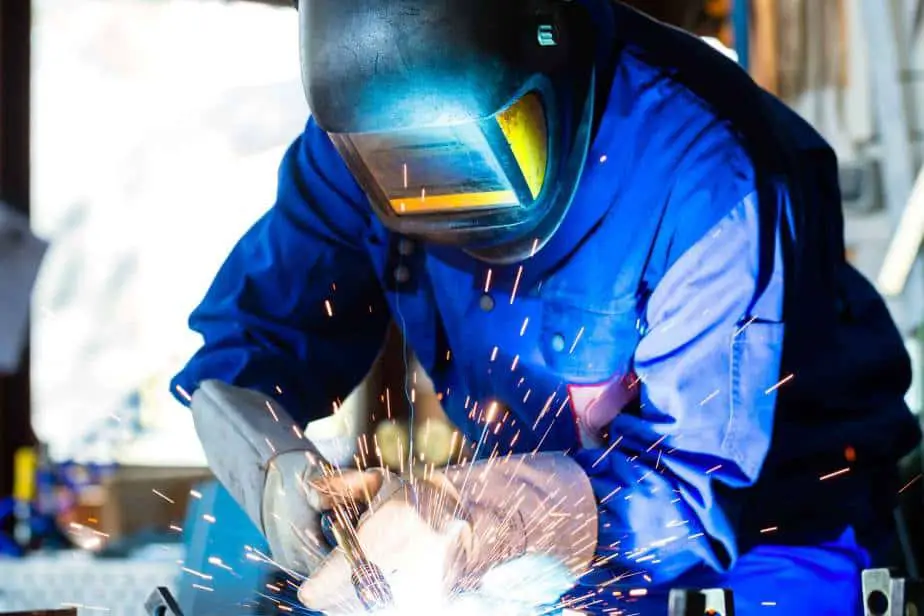
We will break down everything you need to know about buying a welding helmet so that it meets safety standards and allows you to produce clean welds. The differences between helmets largely come down to preference and the type that will make the most sense for your welding environment.
Are There Different Types of Welding Helmets?
Welding helmets are available in two primary categories but with a variety of options in each, ranging from very simple protection to advanced technology that changes to your viewing needs. Welding helmet choices are very specific to the individual user, often reflecting their preferences for ease of use and budgetary constraints.
The two types of welding helmets available are passive welding helmets and auto-darkening helmets. Within each type, there are variations that may make more sense for your needed welding applications.
Passive Welding Helmets
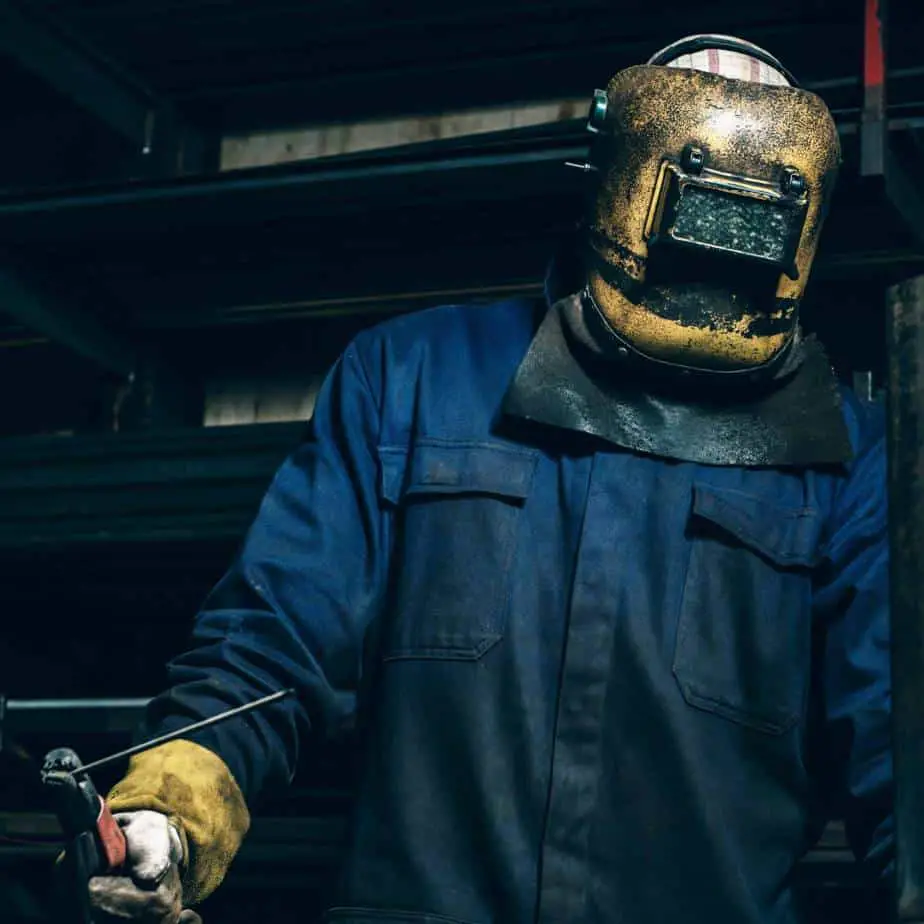
Passive welding helmets offer the simplest technology available. With a fixed lens, they aim to protect a welder from the harmful UV light spectrum that causes long-term eye damage. These helmets are the most economical as they do not offer additional features beyond protection while in use. The fixed lens strength will depend on the intensity of light created by your welds. These lenses can be manually switched for light levels.
To use a passive welding helmet, you need to manually pull the hood over your face and make sure it locks into place for full protection. To check your weld when the welder is turned off, you will need to remove the shield of the helmet every time. For some users, this can be inconvenient and slow down a welding project.
There are two common types of passive helmets: flip hoods and pancake hoods. Flip hoods are the most common as they ‘flip’ or pull over your face for protection.
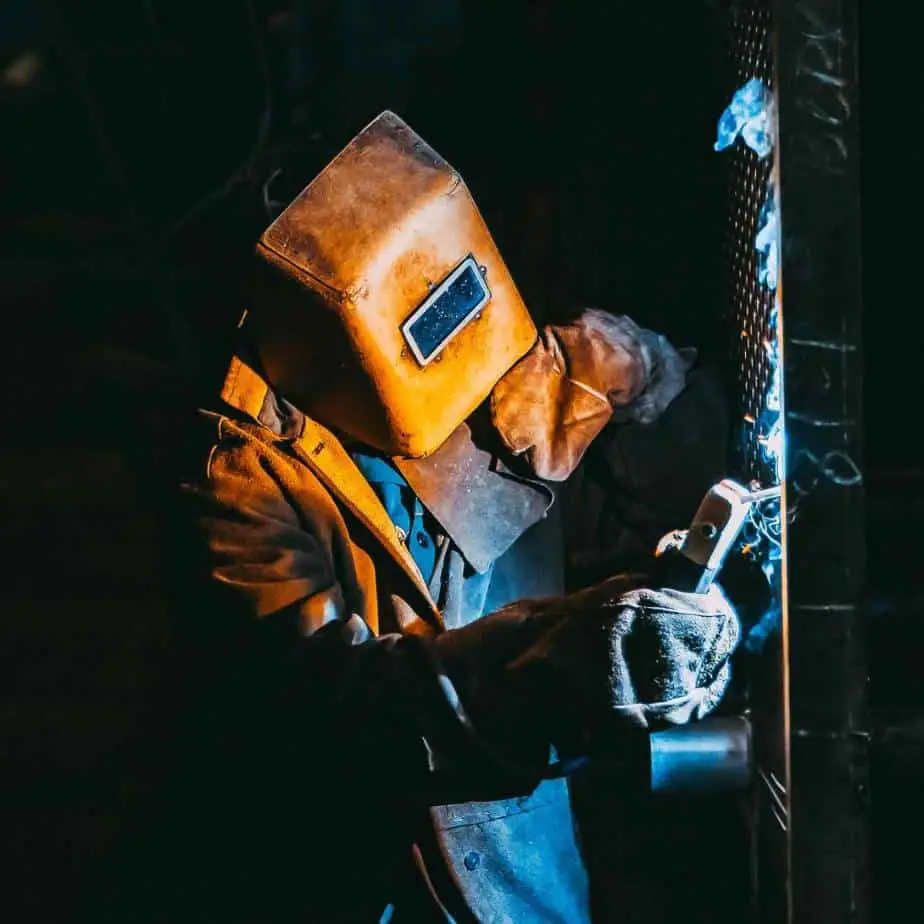
A pancake hood is shaped like a pancake but secures onto your eyes with a goggle-like settlement for less glare and better eye protection. They are often used for outside projects at odd angles by pipe workers. They work great so long as you are doing the same type of welding on a project for long periods of time. Stopping to change lenses mid-project is a waste of time.
The primary benefits of using a passive welding helmet include:
- Inexpensive: Compared to other models on the market, passive welding helmets are the cheapest while still being safe and effective. This is because of the simple design and limited mechanics.
- Simplicity: You only need to put it on and make sure it is pulled down completely over your face for it to work. It will usually snap into place depending on the model, so you know it is fully pulled down into position.
- Lightweight: With limited technology, passive welding helmets are lightweight will make welding over long periods of time more comfortable (unless flipping helmet up and down often, which can result in neck pain).
- No power required: More advanced helmets will require some sort of power source to operate, which adds an additional cost or time when not ready to use. Passive helmets can be used all the time with limited operational constraints.
Passive helmets are no longer the most popular type of welding helmet on the market, but they are consistent performers for those who need little variation in lighting and do not mind manually operating their gear.
Auto-Darkening Welding Helmets
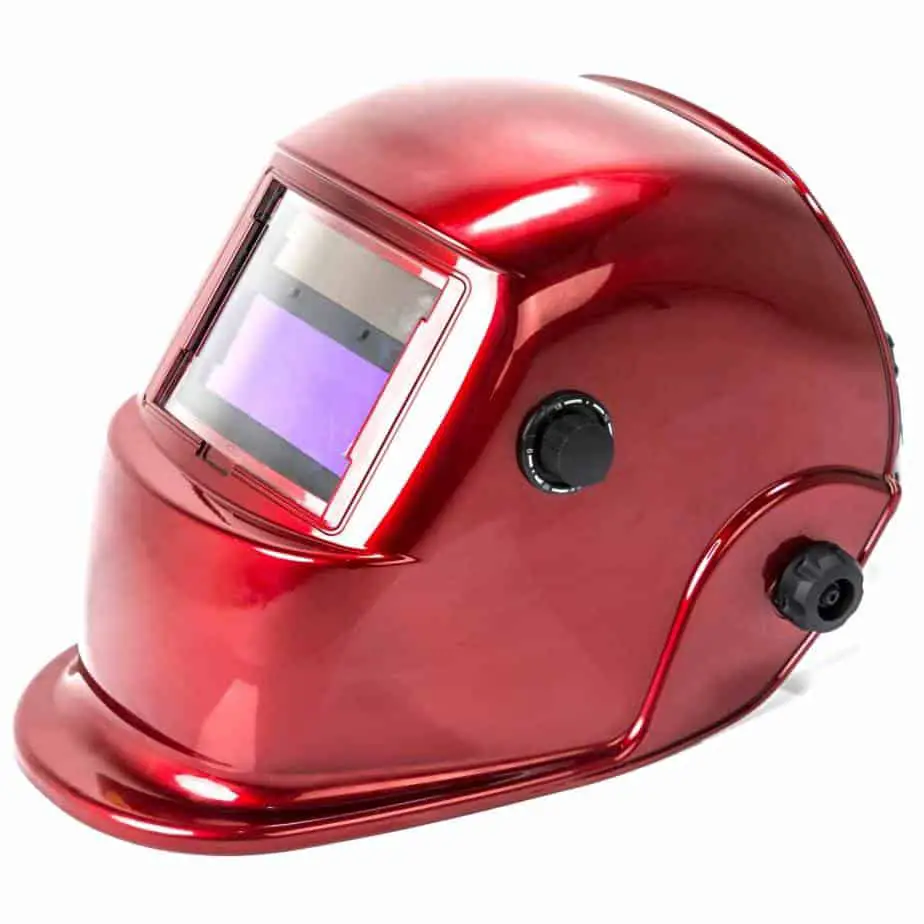
Auto-darkening welding helmets are much more technologically advanced. This is because they automatically adjust their lens and darkness when a weld begins. The lenses are engaged with the presence of a welding spark to protect your eyes. Auto-darkening helmets come in a variety of options, all of them offering very distinctive features:
- Fixed-shade lens: The helmet will automatically darken to a set shade. This option is helmet specific, and I don’t see them very often anymore. They are typically on the older side and are a bit dated, but they are around hobbyist garages. This is best if only a definite darkness level is needed for all your welds (one or similar intensities of welding). These lenses are typically made of shaded glass that can be interchanged based on your needs. I do not prefer this style. I like options.
- Variable-shade lens: Helmets with a variable-shade lens will adjust to different darkness levels depending on the intensity of the light being created during a weld. These helmets are recommended for versatility in doing different types of welding or grinding. Variable-shade lenses use LED glass for easy changes in the darkness level. There are 2 ways your helmet can power the variable shade. Here they are.
- Battery-operated helmet: The automatic adjustments will require a power source, and batteries are a popular one. They are reliable but will require additional costs of battery replacement. That’s not such a big deal if you weld primarily indoors, as solar-powered helmets aren’t your best option there. Batteries last awhile, but you need to make certain you are staying aware and changing them out if you notice welding helmet flashes or other delays (check out our article on welding helmet flashing fixes here for some great tips). The lack of sunburn on your eyeballs will be thanks enough.
- Solar-powered helmet: The alternative to battery-powered is solar, which requires leaving the helmet in the sun to charge. This will not require additional costs but could be inconvenient if not fully charged. Some models allow for a battery option as well. Many high-quality helmets will be a hybrid with batteries as well as solar panels. The hybrid is my preference, but not always for the budget-conscious.
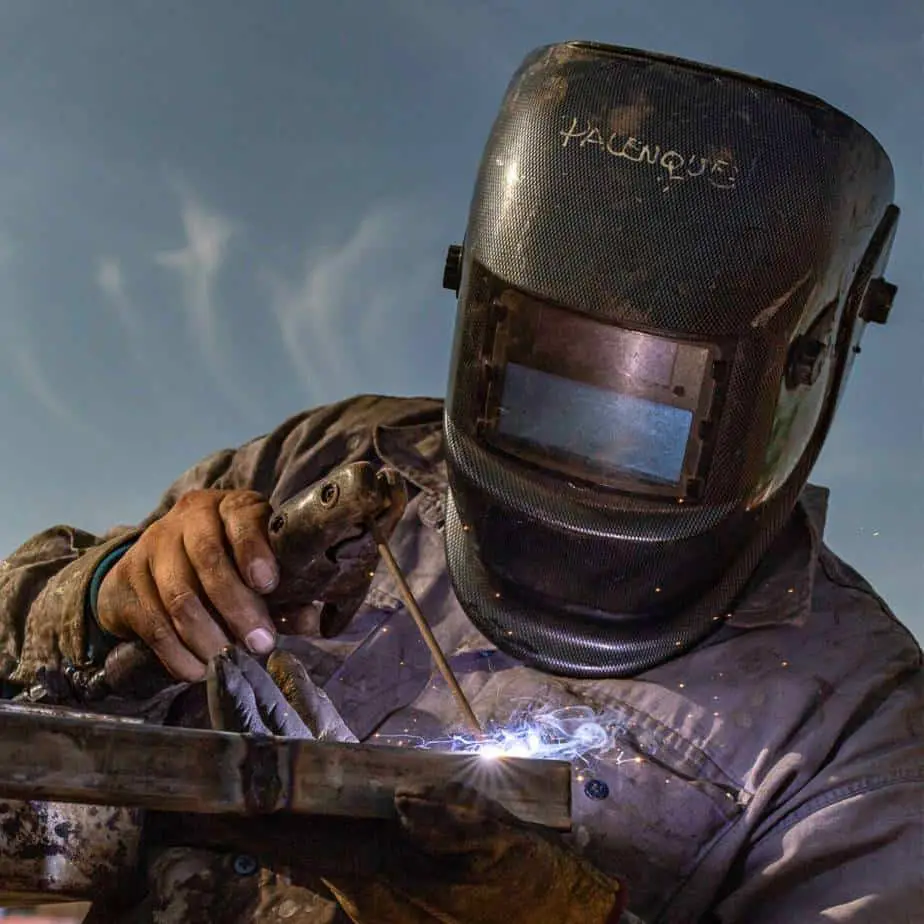
Auto-darkening helmets are more expensive than passive helmets, and for good reason. In my option, their additional features and ease of use make them worth the additional cost for most. You can find quality auto-darkening welding helmets at several price points with all budgets in mind. Check out this next section to see what we like and why. You won’t be disappointed.
What is the Best Welding Helmet You Can Buy?
The best welding helmets will vary based on your needs, all with the same end goal of protecting you while you produce clean and secure welds. Auto-darkening helmets are the best helmets available on the market, and we have selected the ones that deliver at every price point. Your eye protection is worth the extra price tag!
When purchasing a welding helmet, we recommend looking at the reviews of products you are interested in before making your choice. They may have all the features you are looking for, but you want to make sure these actually work. Welders and users will be able to offer their honest advice on the quality of a product so you can feel confident about your choice.
1. Lincoln Electric Viking 3350: High-End Option
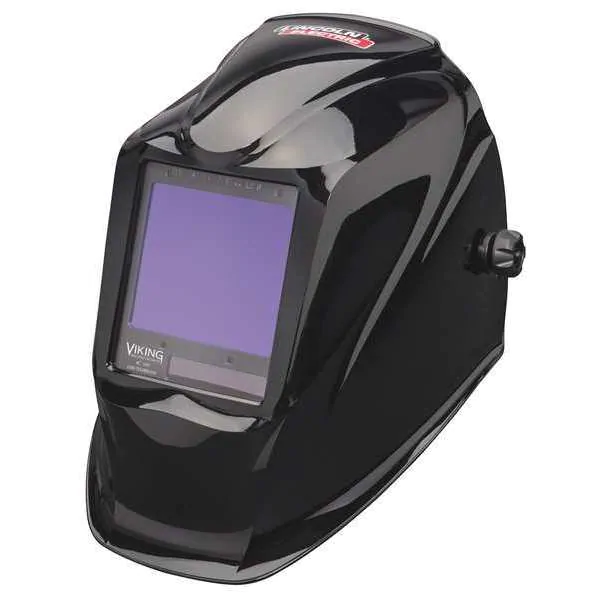
The Lincoln Electric Viking 3350 is an auto-darkening welding helmet that we highly recommend and is very versatile for all types of welding.
- It will adjust to different intensities of light with a 5 to 13 shade range (greater than most auto-darkening helmets).
- It offers great visibility in screen quality and a large viewing screen while welding, making it easier to see your work clearly.
- The helmet has a quick response time to changes in light for optimal eye protection
- This model is solar powered. It will require keeping the helmet near a light source for passive charging (will also charge while using when outside).
- It also emphasizes comfort by carefully balancing weight distribution, meaning a longer working time for you without pain.
If you value your vision and want to work longer to make more money or play harder, this is the no-brainer option. Users may find that the helmet is difficult to initially fit and adjust but is very comfortable and efficient once set up. The helmet is designed to form fit to your head for increased customization while in use. Check out our recommendation here, I cannot recommend this helmet enough.
2. Hobart 770890 Auto-Darkening: Mid-Range Option
My next favorite auto-darkening welding helmet, the Hobart 770890 Auto-Darkening, can be used for a wide variety of jobs.
- It is sturdy and responds quickly with four arc sensors.
- It has a large viewing area to gain greater visibility on your welds.
- This helmet stands out in clarity over all other categories, making it a great option to clearly see what you are working on.
- It has solar panels on the exterior to assist in the battery charging while not in use.
- While it is heavier compared to others in the category, it is still comfortable and can be used for long periods of time to tackle bigger projects.
This helmet is recommended for all welding projects and is designed for consistent use, so it will be suitable for a professional or a hobbyist.
3. YESWELDER LYG-M800H: Mid-Range Option
I also really like the YESWELDER LYG-M800H auto-darkening helmet. It is battery-operated with supporting solar panels for consistent operating power. This helmet is recommended as a beginner helmet for those who may not need it for daily usage. If you work on hobby welding projects, this may be the helmet for you as it comes at a reasonable price point.
- The response time to light adjustment is shorter, which is not as ideal as other options that have more arc sensors.
- This helmet has a clear viewing area and works up to a shade #13 to work on more high-intensity welds.
- This particular model comes with back up lenses and a replacement battery, adding to the value.
The helmet is particularly recommended for TIG, MIG, MMA, plasma welding types, but as long as your welding intensity stays below the needs of a #13 shade, it will be a suitable option.
4. Antra Auto Darkening AH7-360-0000: Value Option
For the best value welding helmet, I highly recommend the Antra Auto Darkening AH7-360-0000 for beginners or infrequent usage because it is not as durable as higher-end models.
- The clarity is good for the price point
- It does have a smaller viewing area.
- It offers shades ranging from 5 to 13 and an additional permanent shade 13 for extra protection.
- There are four arc sensors to quickly respond to changes in light automatically to minimize strain on the eyes when engaging the weld arc.
- It works to respond specifically to welding sparks and not outside or workshop lighting. The helmet offers full neck protection to avoid injury resulting from sparks and radiation.
This model is also solar powered for consistent battery recharging. It is versatile and lightweight compared to other models, so it will get the job done for you if you need something simple. It can be used for nearly all types of welding and metal fabrications applications.
What Should I Look For in a Welding Helmet?
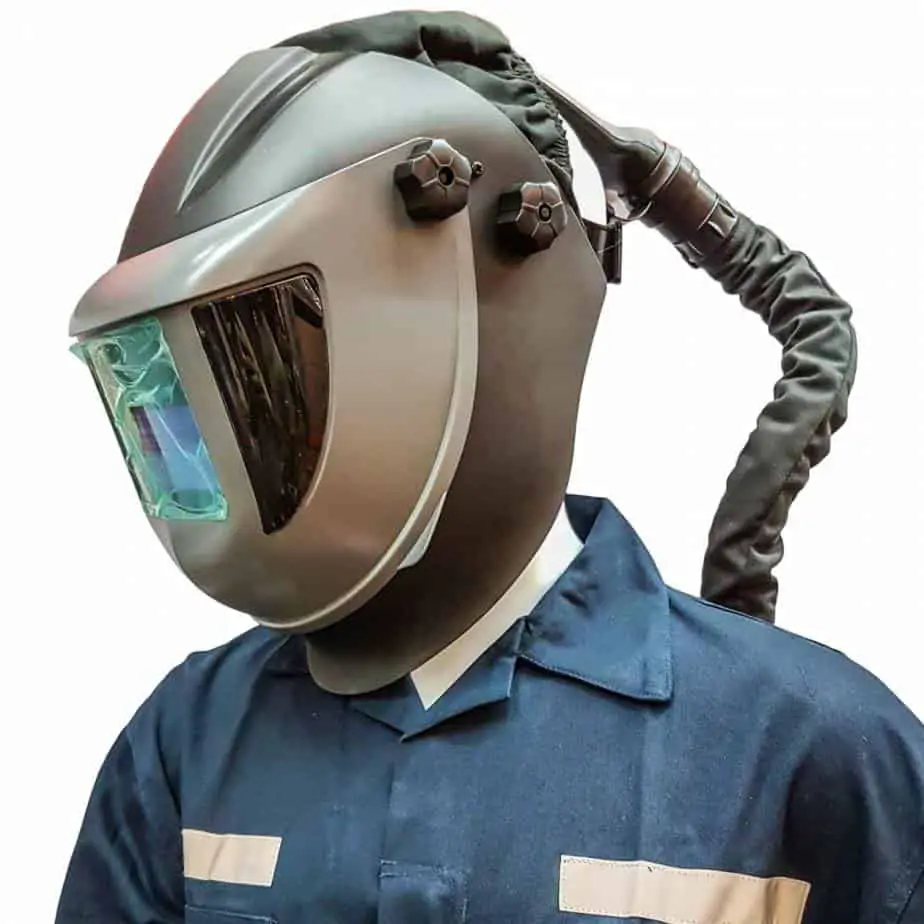
What you look for in a welding helmet will vary based on the types of projects you work on and the level of convenience you hope to get out of the helmet. As the choices for best welding helmets show above, there are some consistent characteristics that are very important for protection and achieving a quality weld.
You should look for an auto-darkening welding helmet over a passive one when possible. These helmets offer significantly more features and make your welding experience much easier. Especially if you spend a lot of time welding, auto-darkening is more efficient! An auto-darkening helmet will also help you become a better welder faster if you are just starting out.
Here’s a great video explaining why.
These are the important factors you should consider when purchasing a welding helmet:
- Safety standards: Welding helmets are designed for protection from ultraviolet and infrared light, flash burns, sparks, heat, etc. They must pass safety inspections and meet standards to ensure that welders are protected from these dangers. Different types of welding require specific lenses to protect you, and most helmets cover this range. Here’s a link to the OSHA standards for eye protection in a welding environment. Heed these. They are smart.
- Coverage: You will want to choose a helmet that not only covers your eyes and face but, ideally, your neck to limit any skin exposure. This will prevent the light, spark, and debris that could cause burns or injuries. We talk about this a bit in our article covering the most common welding mistakes found here.
- Darkening response time: Sensors in auto-darkening helmets allow for a fast reaction time from full clarity to safe, dark shades. Helmets should have between 2 and 4 sensors, with more sensors offering greater speed and effectiveness.
- Clarity and view area: Having a clear view of the weld that you are working on is crucial for accuracy. Higher quality lenses and larger viewing areas are preferred for the ideal working environment. The American Welding Society has a very well written document outlining these standards and recommendations that you can read here.
- Power source: Choosing a battery-powered, solar-powered, or hybrid of the two will depend on your preference. Typically, hybrids will offer the longest-running time as they continue to charge while in use if the solar panels have contact with the sun. Solar-powered helmets will automatically turn on, unlike batteries that need a switch. I recommend a hybrid, as the Lincoln Electric Viking 3350 utilizes a hybrid system and I love it.
- Comfort: If you spend many hours welding, you will want something that is comfortable. A passive helmet may not be best as you have to shift your neck to flip the hood up and down every time you look at the weld. Look for a helmet with equal weight distribution and one that is lightweight.
- Convenience: Some models will have more buttons than others, passive helmets will require constant movement of the hood, and you may need to change the lenses manually. You can purchase models that will do all of this for you if convenience is a top priority for your welding.
Meeting safety standards should be the top priority in a welding helmet before any other factors are considered. Helmets that are made by reputable manufacturers will pass these standards and will protect you from the harmful emissions created by using a welding machine.
What is a Welder’s Helmet Called?
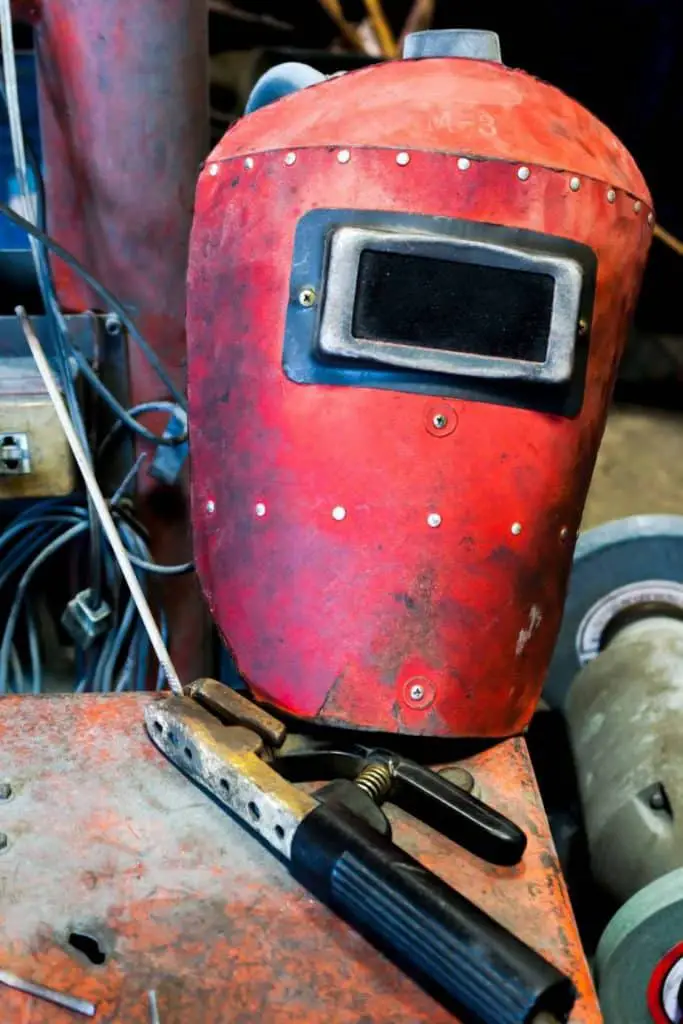
Welding helmets are important personal protective equipment that should be used whenever you are operating a welding machine. Welding helmets are often called ‘hoods’ because of their shape and the way in which they come down over the face. Some early designs did not cover your entire head like today’s helmets do, so they simply acted as a hood shield.
Many welders still refer to welding helmets as hoods as a colloquial term for the piece of equipment, but they can be used synonymously to refer to the face and head protection.
Pancake hoods (the passive helmets that cup over your eyes) are one of the only models that still formally use “hood” in their name. Today, you will find that hoods are called welding helmets more commonly because they are more descriptive to the actual device that covers your entire head.
How Dark Should a Welding Helmet Be?
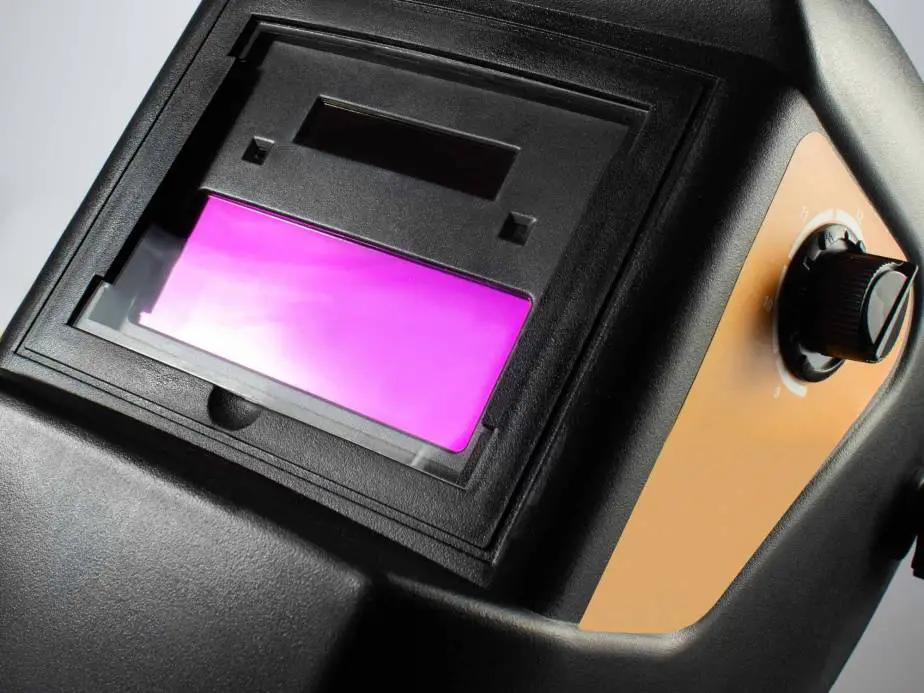
The level of darkness in a welding helmet refers to the shade protection offered in a lens that covers your eyes. These lenses can be passive or automatic, depending on the complexity of the helmet you have. Having multiple shades on a welding helmet is necessary to protect you from the varying levels of brightness that different welding types produce without manually changing out the lense.
Welding shades typically range from 5 to 13/14 (with 14 being the darkest and most protective). Levels between 3 and 5 are what you would typically see when the helmet has not been activated, giving you a full range of vision that is not impaired by any darkened lens. This will darken with an auto-darkening lens once the welding light triggers the sensors.
The type of welding you do will dictate the level of shading you need. The best welding helmets will allow for auto-darkening across this entire shade range so that you do not have to make any manual adjustments. We strongly advise you to look into an auto-darkening helmet.
These are the shade settings that are required for different types of welding:
| Stick welding | For this type of welding, 9-13 shades are required to protect you at varying amperages, offering less intensity than many other types of welding with a #9 starting point. |
| MIG welding | This form of welding requires 10-13 shades for proper protection. |
| Aluminum MIG welding | Also requiring 10-13 shades, you will reach the #13 at a lower amperage than in standard MIG. |
| Flux-cored welding | Flux-cored amperage measurements to shade levels fall within the 10-13 range as well. |
| TIG welding | For this welding method, you will need between 9-13 shades in your lens. |
What Do the Numbers Mean?
The higher end of the shade range represents the greater amperages employed during a weld. Amperages are used to measure the strength of current during a weld. Higher amperages will increase the level of penetration into a piece of metal, with some methods requiring higher levels of current than others. These increases also impact the light that is emitted.
These higher levels of current increase the intensity of light and requires more eye protection by way of a darker shade. You should purchase a welding helmet with these shade measurements in mind. If you plan to practice multiple melding methods, you should go opt for one that covers up to shade #14. Your vision is worth it.
How Do You Trigger Auto Darkening Welding Helmet?
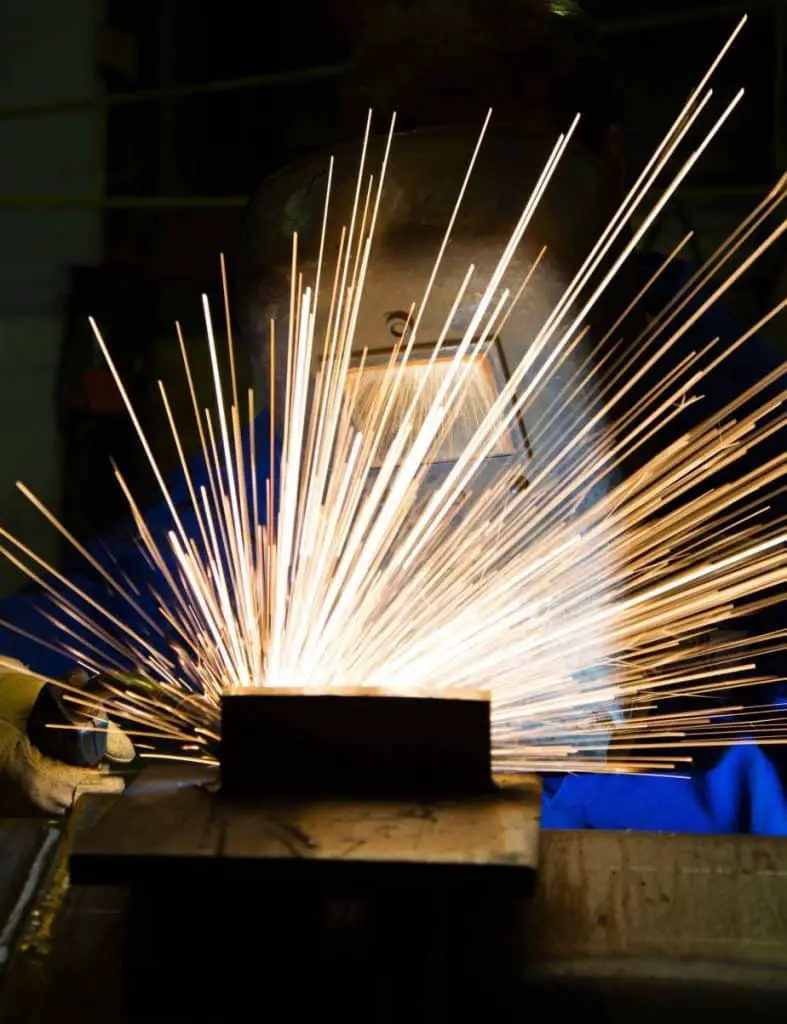
Auto-darkening helmets trigger themselves, which is exactly why they are so valuable. You simply need to strike an arc and the lens will adjust to the appropriate darkness shade in order to properly protect your eyes. The sensors in the helmet are designed to automatically detect the intensity of the light and adjust accordingly.
Before you use your auto-darkening helmet for the first time or to make sure it is on and running, you should consider testing the helmet. When you first turn on the helmet, you should be able to see clearly at a #3 or $4 setting (standard light without filtering). Look up towards the sun so you can see the changes in lighting.
When looking up at the sun, you should take note of a few things:
- Change in darkness: You will notice a visible difference in the coloring of the shade and if it is getting darker. This will be a clear sign that the triggering was successful, and you can use it on a weld. If it does not trigger, you should first adjust the sensitivity level. If this does not make a difference, you should not use the helmet during a weld until the helmet is fixed.
- Reaction speed: The speed at which the sensors kick in matters to keep your eyes protected. Any delay in triggering the darker lenses while welding could cause significant eye strain or possible damage. It should react so quickly that you do not even notice a delay, refer to your user manual for the ideal speed. If the reaction time is anything less than nearly instant, it may not be the best quality.
- Clarity: It will be hard to see anything clearly when looking at the sun, but you will be able to quickly look around you and check to see if there is still visibility when the shade is dark. Clarity is best identified when looking at a lit weld, as this is the best indicator of its effectiveness.
If you think your helmet is too dark, try the troubleshooting tips found here.
Doing these small checks before you use the auto-darkening helmet is important so that you do not stare directly into an intense welding light. When using your welding helmet, there are also adjustments you can make to impact triggering behavior. This particularly applies to the level of sensitivity, which dictates the ease of reaction the welding helmet has to light.
There are dials on most welding helmets that will allow you to adjust the level of sensitivity so that there is a quick response time to welding light changes. It should be set to adjust to your likeness, but not so dramatically that any change in light will make the helmet too dark to see what you are working on.
Other Safety Considerations with a Welding Helmet
When you are using a welding helmet, you will need to make sure it is turned on (if it does not turn on itself) and locked into place. The helmet should sit comfortably, yet firmly on your head so that it does not move around or open up while you are working on a project. It is still recommended that you wear safety goggles underneath the welding helmet for optimal eye protection.
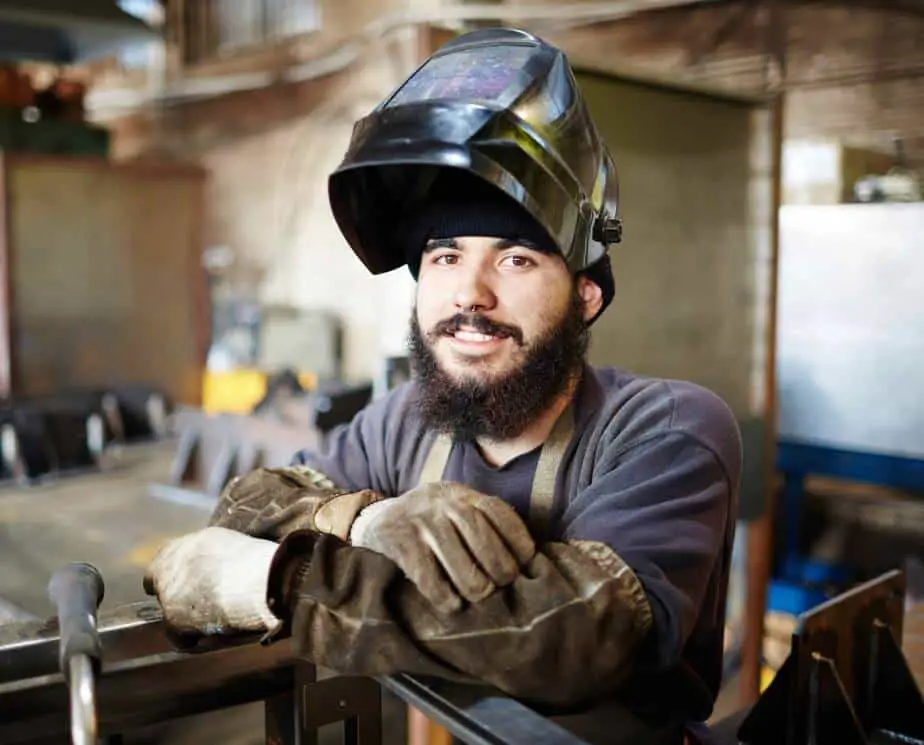
These are some additional precautions you should take when wearing a welding helmet to keep yourself safe:
- Full body protection: Limiting the exposure of your skin is very important for protection from sparks and heat. Even if you are wearing a welding helmet, we recommend having some sort of clothing or fabric covering your neck in the event that sparks contact the skin below your helmet.
- Stop if there is no adjustment: While working, if you notice there is no adjustment in darkness, you should stop welding. Something may be faulty with the sensors that are designed to trigger the darker lenses.
- Noise protection: You may also want to consider wearing earplugs or some form of noise protection underneath your helmet to combat intense noises made by your welding machine.
- Respirator: Fumes are a real issue, and the dangers are even more so. Please read more about the dangers of fumes and the necessity of wearing your respirator here. Please wear a respirator. You can find our recommended respirators here. Please take this seriously.
- Only use your helmet for welding: It is not recommended to use a welding helmet for all dangerous cutting and metalworking. If you are working with lasers, welding helmets may not be strong enough and could still cause injury to the eyes or face.
Your Most Important PPE for Welding
Welding is a dangerous profession/activity if the necessary safety precautions are not taken seriously. The welding helmet is the most important piece of safety equipment because it keeps your eyes from damage caused by ultraviolet and infrared lights, as well as sparks and intense heat. Selecting a quality helmet will ensure that safety is upheld.
When buying a welding helmet, we recommend an auto-darkening helmet because it provides you with optimal protection for most welding types and is the most technologically advanced to be used easily. From there, the best helmet in the category will depend on your project types and your priorities in a helmet.
